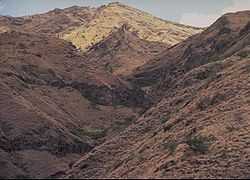Danakil Depression

The Danakil Depression is the northern part of the Afar Triangle or Afar Depression,[1] a geological depression that has resulted from the presence of three tectonic plates in the Horn of Africa. The Danakil Depression is located in the Afar Region near the border with Eritrea and Djibouti. This area is referred to as the cradle of hominids after Donald Johanson and his colleagues in 1974 found the famous Lucy Australopithecus fossil, which has been dated 3.2 million years old.[2]

The Danakil Depression is among the hottest place on earth in terms of year-round average temperatures. It is also one of the lowest places on the planet, and there is no rain for most of the year. Here, the Awash River dries up in a chain of salt lakes never reaching the Indian Ocean.[3]
Mount Ayalu is the westernmost and older of the two volcanoes at the southern end of the Danakil Depression. The other active volcano, Erta Ale, is one of several magma crater lakes bubbling from the earth's core. Additionally, the area contains the Dallol sulfur springs.
See also
References
- ↑ Beyene, Alebachew & Abdelsalam, Mohamed G. (2005). "Tectonics of the Afar Depression: A review and synthesis". Journal of African Earth Sciences 41 (1–2): 41–59. doi:10.1016/j.jafrearsci.2005.03.003.
- ↑ "Danakil Depression". Insideethiopiatours.com. Retrieved 2013-12-10.
- ↑ "Africa's Danakil Desert - National Geographic Magazine". Ngm.nationalgeographic.com. Retrieved 2013-12-10.
External links
| ||||||||||||||||||||||||||||||||||||||||||
Coordinates: 14°14′30″N 40°18′00″E / 14.2417°N 40.3°E